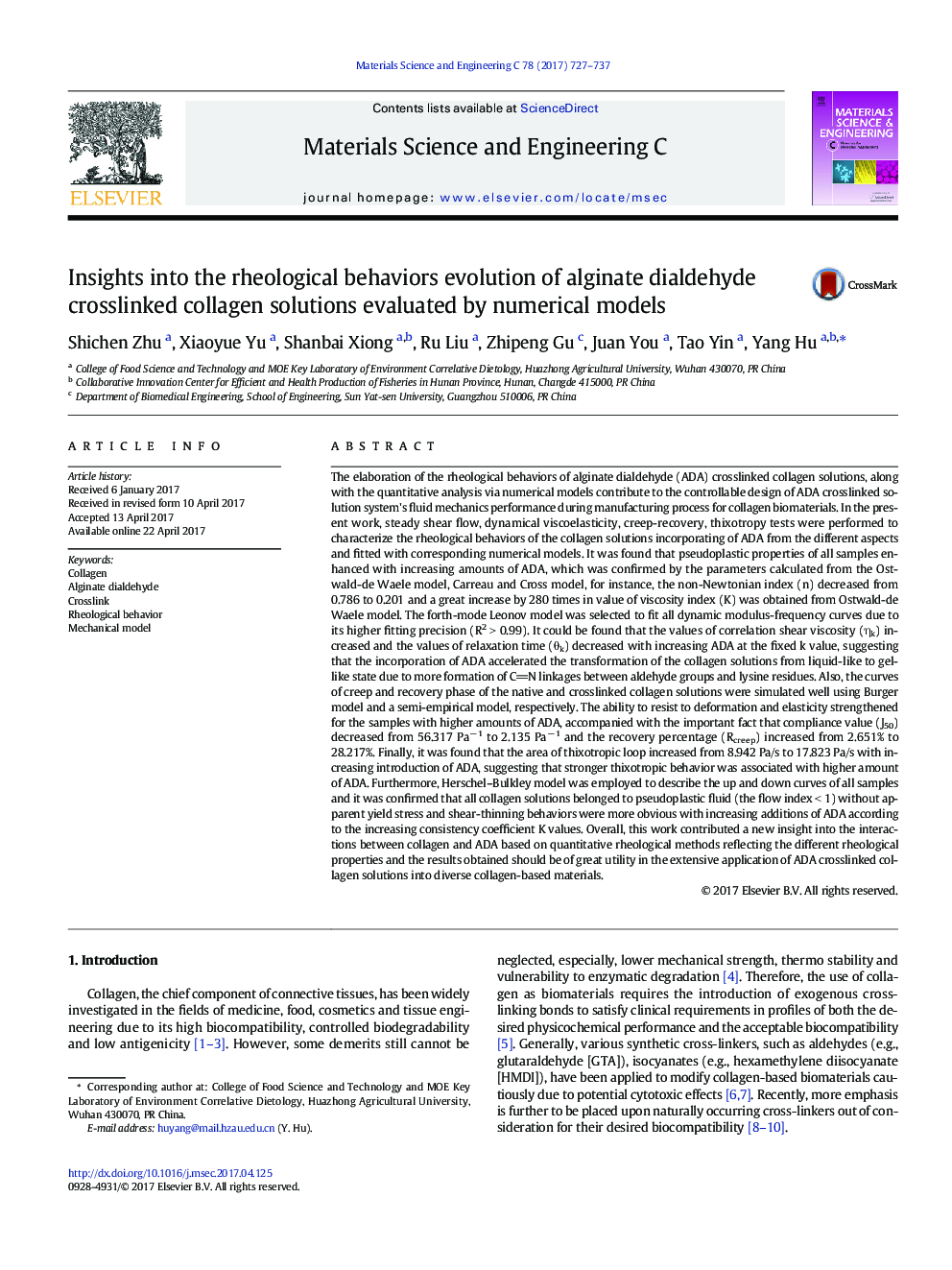| کد مقاله | کد نشریه | سال انتشار | مقاله انگلیسی | نسخه تمام متن |
|---|---|---|---|---|
| 5434467 | 1509143 | 2017 | 11 صفحه PDF | دانلود رایگان |
- Comprehensive rheological behaviors were analyzed by corresponding numerical models.
- High-dosage ADA-collagen solution showed a tendency towards gel-like state.
- The pseudoplasticity and thixotropicy of the ADA-collagen solutions enhanced.
- The intensity and elasticity reinforced for ADA-collagen solutions.
The elaboration of the rheological behaviors of alginate dialdehyde (ADA) crosslinked collagen solutions, along with the quantitative analysis via numerical models contribute to the controllable design of ADA crosslinked solution system's fluid mechanics performance during manufacturing process for collagen biomaterials. In the present work, steady shear flow, dynamical viscoelasticity, creep-recovery, thixotropy tests were performed to characterize the rheological behaviors of the collagen solutions incorporating of ADA from the different aspects and fitted with corresponding numerical models. It was found that pseudoplastic properties of all samples enhanced with increasing amounts of ADA, which was confirmed by the parameters calculated from the Ostwald-de Waele model, Carreau and Cross model, for instance, the non-Newtonian index (n) decreased from 0.786 to 0.201 and a great increase by 280 times in value of viscosity index (K) was obtained from Ostwald-de Waele model. The forth-mode Leonov model was selected to fit all dynamic modulus-frequency curves due to its higher fitting precision (R2 > 0.99). It could be found that the values of correlation shear viscosity (ηk) increased and the values of relaxation time (θk) decreased with increasing ADA at the fixed k value, suggesting that the incorporation of ADA accelerated the transformation of the collagen solutions from liquid-like to gel-like state due to more formation of CN linkages between aldehyde groups and lysine residues. Also, the curves of creep and recovery phase of the native and crosslinked collagen solutions were simulated well using Burger model and a semi-empirical model, respectively. The ability to resist to deformation and elasticity strengthened for the samples with higher amounts of ADA, accompanied with the important fact that compliance value (J50) decreased from 56.317 Paâ 1 to 2.135 Paâ 1 and the recovery percentage (Rcreep) increased from 2.651% to 28.217%. Finally, it was found that the area of thixotropic loop increased from 8.942 Pa/s to 17.823 Pa/s with increasing introduction of ADA, suggesting that stronger thixotropic behavior was associated with higher amount of ADA. Furthermore, Herschel-Bulkley model was employed to describe the up and down curves of all samples and it was confirmed that all collagen solutions belonged to pseudoplastic fluid (the flow index < 1) without apparent yield stress and shear-thinning behaviors were more obvious with increasing additions of ADA according to the increasing consistency coefficient K values. Overall, this work contributed a new insight into the interactions between collagen and ADA based on quantitative rheological methods reflecting the different rheological properties and the results obtained should be of great utility in the extensive application of ADA crosslinked collagen solutions into diverse collagen-based materials.
159
Journal: Materials Science and Engineering: C - Volume 78, 1 September 2017, Pages 727-737
